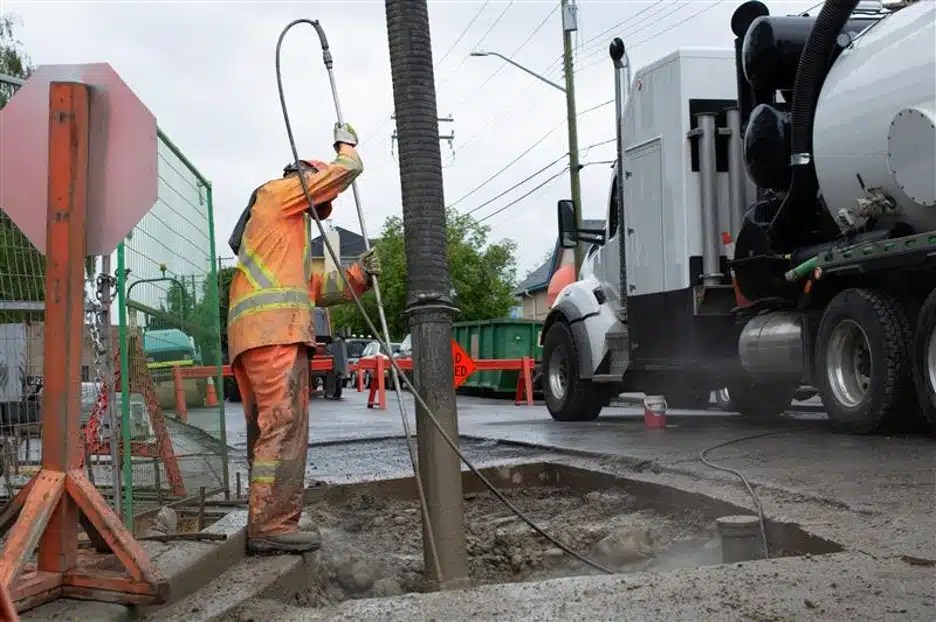Excavating in the dense, intricate landscape of a modern city presents unique challenges.
Traditional methods like backhoes or manual digging often lack the precision, safety, and efficiency required in such environments.
That’s where hydro excavation steps in – a non-destructive, highly accurate technique that uses pressurized water and a vacuum system to break up and remove soil.
This method has quickly gained traction in urban projects due to its alignment with the needs of contemporary infrastructure work.

Hydro excavation provides a non-destructive, highly accurate alternative, using pressurized water and a vacuum system to break up soil and remove it.
Pinpoint Accuracy in a Complex Underground
Beneath city streets lies a tangled web of utilities—gas lines, water pipes, fiber optics, electrical conduits, and sewer systems. These are frequently undocumented or inaccurately mapped, turning excavation into a high-risk endeavor. Hydro excavation offers a solution by enabling crews to uncover utilities with exceptional precision and minimal risk. The water loosens the soil gently, while the vacuum clears it away, exposing infrastructure without causing harm.
This level of control is especially critical in urban settings, where space is tight and errors can be costly. Unlike mechanical digging, hydro excavation minimizes the chance of damaging essential systems, reducing the risk of service disruptions, expensive repairs, and safety hazards.
Prioritizing Safety for Crews and Communities
Safety is paramount in any excavation, particularly in crowded urban areas. Traditional digging methods can lead to cave-ins, equipment mishaps, or accidental utility strikes. Hydro excavation significantly reduces these risks by limiting the use of heavy machinery and easing the physical burden on workers.
Because it avoids direct mechanical contact, this method lowers the chance of hitting live electrical lines or pressurized gas mains – making it ideal for work near sensitive infrastructure. It also generates less noise and disruption, creating a safer, more tolerable environment for nearby residents and businesses.
Protecting the Urban Environment
Excavation in cities often occurs near buildings, roads, and landscaping that must remain intact. Traditional digging can inadvertently damage these surroundings. Hydro excavation, on the other hand, is minimally invasive. Its targeted approach allows crews to dig only where necessary, preserving nearby structures, tree roots, and pavement.
Efficiency That Pays Off
Though hydro excavation may appear more specialized – and therefore more costly – it often proves more economical over time. Its speed and accuracy help reduce labor hours, avoid utility damage, and minimize project delays. In urban environments where time is money, these benefits can be substantial.
Beyond utility exposure, hydro excavation is versatile. It’s effective for trenching, potholing, daylighting, debris removal, and even cold-weather digging, thanks to heated water systems. This adaptability makes it a valuable asset for municipalities, contractors, and utility providers.
Meeting Regulations and Managing Risk
With cities enforcing stricter excavation regulations to protect infrastructure and public safety, hydro excavation offers a compliant, low-risk solution. Its precision reduces the likelihood of utility strikes and environmental harm, helping contractors stay within legal boundaries and avoid penalties.
Insurance companies also recognize the reduced risk, which can lead to lower premiums and fewer claims. For project managers and city planners, this translates into more predictable outcomes and better risk management.
The Essential First Step: Utility Locating
Despite its many benefits, hydro excavation is only as effective as the information guiding it. Accurate utility locating and mapping must precede any digging. While contacting 811 is a critical first step, it’s important to remember that not all utilities are registered with this service.
Hiring a private utility locating firm to supplement 811 data ensures a comprehensive understanding of what lies underground – whether it’s public or privately owned. This proactive step helps eliminate the risk of damaging unseen infrastructure during excavation.
GPRS offers 99.8%+ accurate utility locating and mapping services, utilizing ground penetrating radar (GPR) scanning, electromagnetic (EM) locating, and other technologies to Intelligently Visualize The Built World® below your feet. All this accurate, actionable data is uploaded into SiteMap® (patent pending), our infrastructure mapping software application designed to help you plan, design, manage, dig, and ultimately build better.
Click below to schedule a live, personal SiteMap demo today!
